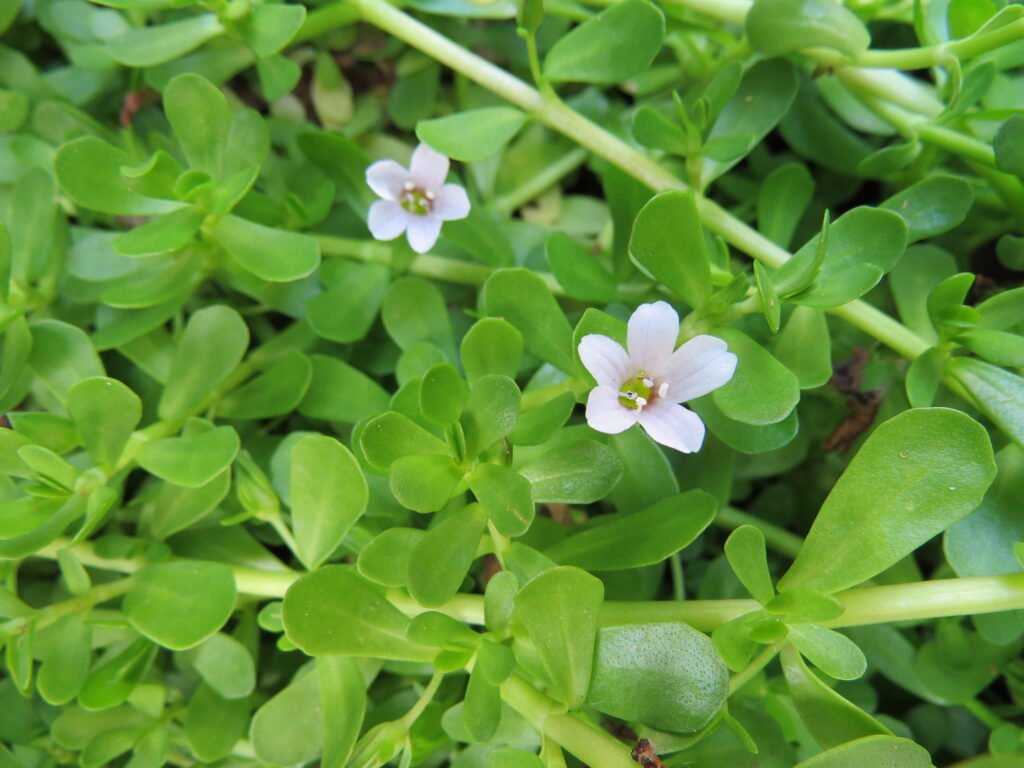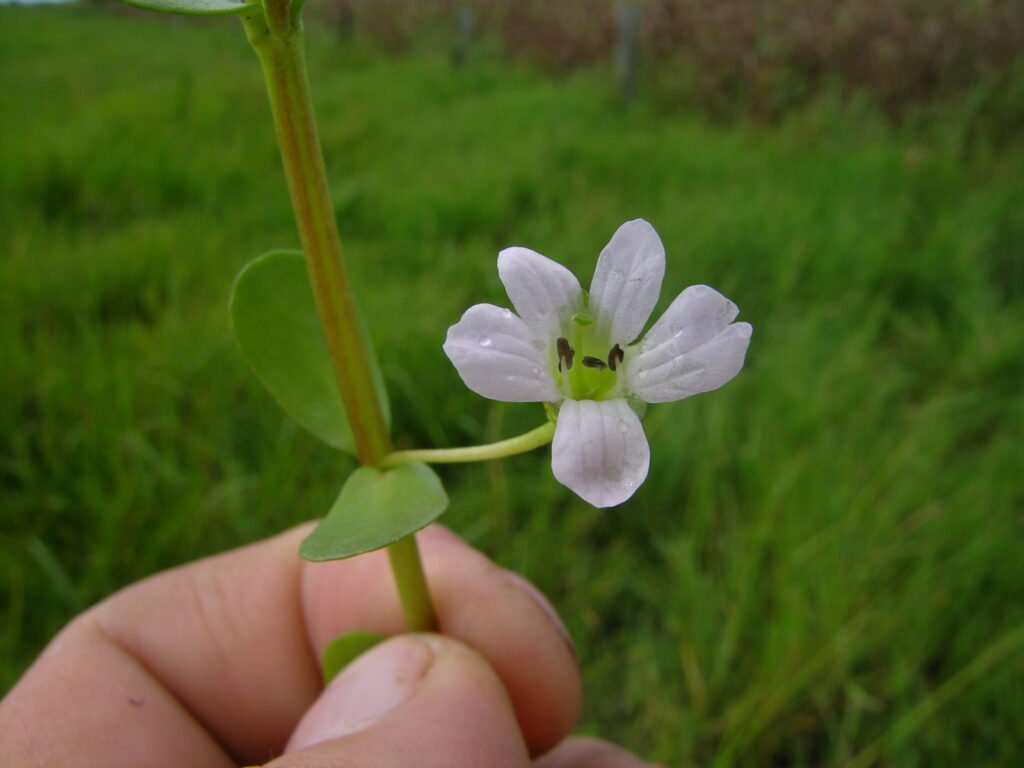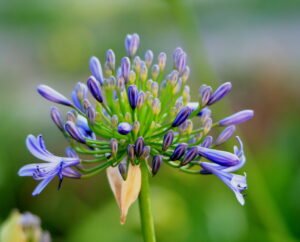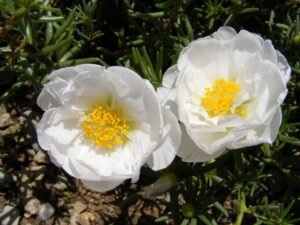How to Grow and Care for Bacopa Plant

Photo by David Eickhoff on flickr license
The Bacopa plant, scientifically known as Bacopa monnieri, is a versatile and resilient perennial that has garnered significant attention from both gardening enthusiasts and herbalists. Commonly referred to as water hyssop or Brahmi, this plant is native to wetlands and marshy areas of India and other tropical regions worldwide. Its ability to thrive in a variety of environments makes it a popular choice for ornamental gardening, particularly in water gardens and hanging baskets. This article explains in detail how to grow and care for bacopa plant.

Characterized by its small, succulent leaves and delicate white or light blue flowers, the Bacopa plant is not only visually appealing but also relatively low-maintenance. The plant’s trailing nature allows it to drape gracefully over the edges of containers or spread across garden beds, creating a lush, green carpet. This adaptability and aesthetic appeal have made Bacopa a favored addition to many gardens.
Photo by Harry Rose on flickr license
Bacopa Plant Facts
Plant History
The historical significance of Bacopa Monnieri in traditional medicine is profound. In Ayurveda, it is revered as a ‘Medhya Rasayana,’ an herbal remedy that enhances memory and intellect. The plant’s use can be traced back over 3,000 years, with ancient texts documenting its efficacy in improving cognitive functions, reducing anxiety, and alleviating symptoms of epilepsy. Modern research continues to explore these traditional claims, with studies indicating that Bacopa Monnieri may indeed support cognitive health and neuroprotection.
Plant Facts
Common Names: Brahmi, Neer Brahmi, Water Hyssop, Jalanimba and Bakopa.
Sunlight: Bacopa Monnieri flourishes best with around 6-8 hours of direct sunlight daily.
Hardiness Zones: Bacopa monnieri is typically suited to USDA hardiness zones 8 to 11. This means it can endure temperatures as low as 10°F to 40°F (-12°C to 4°C) without sustaining significant damage.
Spread & Height: The height of Bacopa Monnieri ranges from 10 to 30 centimeters (approximately 4 to 12 inches). In terms of width, Bacopa Monnieri can extend up to 50 centimeters (about 20 inches) or more, creating a dense mat of greenery.
Flowering Time: Bacopa monnieri tends to bloom during the warmer months, with an optimal flowering period observed from late spring to early autumn. In tropical and subtropical regions, Bacopa Monnieri can flower almost year-round, provided the environmental conditions remain favorable.
Toxicity: In terms of toxicity, there have been few reports of significant adverse reactions in humans or animals. Most studies involving Bacopa Monnieri have not shown any serious toxicological effects, even with prolonged use. A few isolated cases have reported symptoms such as increased bowel movements and stomach discomfort, which again underscores the importance of dosage control.
Annual/Perennial: Bacopa Monnieri exhibits characteristics that suggest it is a perennial plant. Unlike annuals, Bacopa Monnieri does not die after one growing season. Instead, it continues to grow year after year, especially in suitable environmental conditions. This plant is known for its creeping growth habit, where it spreads horizontally across the ground, creating a dense mat of foliage. It can also propagate naturally through stem cuttings and root division, which are common traits of perennial plants.
How To Propagate Bacopa Plant
Propagation of the Bacopa plant can be achieved through several methods, each with its own set of steps and considerations. Whether you’re an experienced gardener or a novice, understanding these techniques will help ensure the successful growth of your Bacopa plant.
Stem Cuttings
One of the most common methods for propagating Bacopa plants is through stem cuttings. This technique is best performed during the growing season, typically in late spring to early summer. To begin, select a healthy, mature Bacopa plant and cut a 4-6 inch section of a non-flowering stem just below a node. Take out as many of the lower leaves from the cutting as possible, leaving the top few. Place the cutting in a container of water or a well-draining potting mix. If using water, ensure it’s changed periodically to prevent stagnation. Roots should develop within a few weeks, at which point the cutting can be transplanted into soil. During this period, maintain a warm, humid environment to promote rooting.
Division
Division is another effective propagation method, especially for larger, well-established Bacopa plants. This method is best carried out in early spring or after the plant has finished flowering in the fall. Carefully remove the Bacopa plant from its pot and gently divide the root ball into smaller sections, each with its own set of roots and shoots. Replant these sections into individual containers or directly into the garden, ensuring they are planted at the same depth as the original plant. Water the divisions thoroughly and keep them in a shaded area until they establish themselves.
Seed Propagation
Propagating Bacopa plants from seeds is less common but can be a rewarding method. Start by sowing the seeds in a seed tray filled with a fine, well-draining potting mix. This process is ideally done in late winter to early spring. Lightly press the seeds into the soil without covering them, as Bacopa seeds require light to germinate. Keep the soil consistently moist and maintain a temperature of around 70°F (21°C). Germination can take up to two weeks. Once the seedlings have developed a few true leaves, they can be transplanted into individual pots or directly into the garden, ensuring they receive ample light and water as they grow.
By mastering these propagation techniques, you can successfully grow and expand your collection of Bacopa plants, ensuring a lush and vibrant display in your garden or home.
How To Plant Bacopa
Planting Bacopa, whether starting from seeds, cuttings, or purchasing young plants from a nursery, is a straightforward process that can yield lush, blooming plants. To begin with, it’s crucial to select the right time of year for planting. The optimal period for planting Bacopa is during the spring after the last frost, as the plant thrives in warm temperatures.
From Seeds
When starting from seeds, it is advisable to sow them indoors approximately 6-8 weeks before the final frost date. Use a seed-starting mix and lightly cover the seeds with soil, as they require light to germinate. Maintain a consistent temperature of around 70°F and keep the soil moist. Germination typically occurs within 1-2 weeks.
From Cutting
If using cuttings, select healthy, non-flowering stems and cut about 4-6 inches below a node. Take out as many of the lower leaves from the cutting as possible, leaving the top few. Put the cutting in a potting mix that drains properly or in a jar of water. Keep the soil consistently moist and provide indirect light until roots develop, which usually takes a few weeks.
From Nursery Plants
For those opting to purchase young Bacopa plants from a nursery, ensure the plants are free from pests and diseases. Before planting, prepare the soil by incorporating organic matter such as compost to improve drainage and fertility. Bacopa prefers well-drained, loamy soil with a slightly acidic to neutral pH ranging from 6.0 to 7.0.
When planting Bacopa, space the plants about 10-12 inches apart to allow adequate air circulation and room for growth. Dig holes that are slightly larger than the root balls of the plants and plant them at the same depth they were growing in their containers. Firmly press the soil around the plants and water thoroughly to help establish the roots.
Regardless of the planting method chosen, it is essential to provide the Bacopa plant with a location that receives full sun to partial shade. Consistent moisture is key, so regular watering is necessary, especially during dry periods. With proper care, the Bacopa plant will flourish, adding vibrant color and texture to your garden.
How To Care For Bacopa Plant
Climate
The Bacopa plant, known for its vibrant greenery and delicate flowers, thrives best when provided with optimal growing conditions. This plant flourishes in temperate climates, where it can receive ample sunlight without being subjected to extreme temperatures. It performs exceptionally well in USDA hardiness zones 9 to 11, where mild winters and moderate summers prevail.
Soil
Soil conditions are another critical factor. The Bacopa plant prefers well-draining soil that is moist yet not waterlogged. The best soil is one that is loamy and rich in organic materials. Soil pH levels should be slightly acidic to neutral, ranging from 6.0 to 7.0. This ensures that the plant’s roots can efficiently absorb nutrients, fostering healthy growth and abundant blooms.
Sunlight
Regarding light requirements, the Bacopa plant grows best in full sun to partial shade. It requires at least six hours of direct sunlight daily to produce its characteristic flowers and maintain robust growth. However, in regions with hotter climates, providing some afternoon shade can prevent the plant from becoming stressed due to excessive heat.
Temperature
Temperature tolerance is also vital for the Bacopa plant’s well-being. While it can withstand a range of temperatures, it performs best in a consistent environment of 60°F to 80°F (15°C to 27°C). Extended exposure to temperatures below 50°F (10°C) can hinder growth and may even cause damage to the plant. Therefore, it is advisable to bring potted Bacopa plants indoors during colder months or unexpected frost periods.
Humidity
Humidity needs are moderate for Bacopa plants. They thrive in environments with humidity levels ranging from 40% to 60%. In drier climates, occasional misting or placing a humidity tray nearby can help maintain the necessary moisture levels in the air, preventing the plant from drying out.
Watering
Proper hydration is crucial for the successful cultivation of Bacopa plants. These plants thrive in consistently moist soil, making regular watering essential. Ideally, Bacopa should be watered thoroughly whenever the top inch of soil feels dry to the touch. This generally translates to watering the plant about two to three times per week, depending on weather conditions and the specific growing environment. It’s important to avoid waterlogging, which can lead to root rot. Ensuring good drainage in the soil or using pots with drainage holes can help prevent this issue.
Signs of overwatering include yellowing leaves and a general wilting of the plant, despite the presence of moist soil. Conversely, underwatering is indicated by dry, brittle leaves and a stunted growth pattern. Monitoring these signs will help you adjust your watering schedule to meet the needs of the Bacopa plant more accurately.
Fertilization
Fertilization is another key aspect of Bacopa plant care. A balanced, water-soluble fertilizer with an equal ratio of nitrogen, phosphorus, and potassium (such as a 10-10-10 mix) is ideal. Fertilize Bacopa plants every two to four weeks during the growing season, which typically spans from spring to early autumn. This frequency ensures that the plants receive a steady supply of essential nutrients without the risk of over-fertilization, which can cause nutrient burn and damage the plant.
Bacopa plants also benefit from organic compost or well-decomposed manure mixed into the soil. These organic materials provide a slow-release source of nutrients, enhancing soil structure and promoting healthier root systems. Additionally, incorporating a micronutrient supplement can be beneficial, supporting overall plant health and vigor.
Pruning and Maintenance
Proper pruning and maintenance are crucial for ensuring that your Bacopa plant remains healthy and vibrant. Pruning is essential to encourage bushier growth and to prevent the plant from becoming leggy. It is recommended to prune the Bacopa plant regularly, particularly during the growing season. This practice stimulates new growth and helps maintain a compact, attractive shape.
To begin pruning, use sharp, sterilized pruning shears. Trim back any long, straggly stems to encourage side branching. It is particularly beneficial to prune just above a leaf node, as this is where new growth will emerge. Regularly trimming the Bacopa plant not only promotes fullness but also enhances its overall appearance.
In addition to pruning, other maintenance tasks are vital for the Bacopa plant’s health. Deadheading, or removing spent flowers, is one such task. This process prevents the plant from expending energy on seed production and encourages continuous blooming. Simply pinch off the old flowers with your fingers or use small scissors for more precision.
Another crucial maintenance task is removing any diseased or damaged foliage. Inspect the Bacopa plant regularly for signs of disease or pest infestation. Remove any affected leaves promptly to prevent the spread of disease and to promote overall plant health. Regular monitoring and timely intervention can significantly enhance the longevity and vigor of your Bacopa plant.
Furthermore, it is essential to ensure that the Bacopa plant receives adequate water and nutrients. While Bacopa plants are relatively low-maintenance, they thrive best in well-drained soil and prefer consistent moisture. Retaining soil moisture and minimizing the need for frequent watering can be achieved by mulching the area surrounding the plant.
By adhering to these pruning and maintenance practices, you will foster a robust and flourishing Bacopa plant. Consistent care not only improves the plant’s appearance but also contributes to its overall health and longevity. Remember that a well-maintained Bacopa plant will reward you with a stunning display of flowers throughout the growing season.
Pest and Disease Management
The Bacopa plant, known for its delicate foliage and vibrant blooms, can fall prey to various pests and diseases. Among the most common pests that infest Bacopa plants are aphids, spider mites, and whiteflies. These insects typically feed on the plant’s sap, leading to weakened growth and the potential spread of viral diseases.
Aphids, small pear-shaped insects, cluster on new growth and flower buds, excreting a sticky substance called honeydew that can lead to sooty mold. Spider mites, often less visible due to their tiny size, cause stippling on leaves and can cover plants with fine webs. Whiteflies, resembling tiny white moths, can cause yellowing and wilting of leaves. To control these pests, start with non-chemical methods like spraying plants with a strong jet of water to dislodge them or introducing beneficial insects like ladybugs and predatory mites.
If the infestation persists, organic treatments such as neem oil or insecticidal soap can be applied. Neem oil has dual functions, acting as both a repellent and a growth inhibitor for many pests. Insecticidal soaps, made from potassium salts of fatty acids, are effective against soft-bodied insects like aphids and spider mites. Ensure thorough coverage of the plant, especially the undersides of leaves where pests often hide.
Bacopa plants are also susceptible to fungal infections, primarily powdery mildew and root rot. Powdery mildew appears as a white, powdery coating on leaves and stems, while root rot manifests through yellowing leaves and stunted growth, often due to overwatering or poorly draining soil. To prevent fungal issues, maintain proper spacing between plants to ensure good air circulation and avoid overhead watering. Fungicides, both organic (like sulfur or copper-based products) and chemical, can be used if the infection becomes severe.
Regularly inspecting your Bacopa plant for any signs of pests or diseases is essential for maintaining its health. Early intervention can prevent minor issues from becoming major problems, ensuring your Bacopa plant thrives and continues to enhance your garden with its beauty.
Seasonal Care and Overwintering
Caring for Bacopa plants throughout the seasons involves understanding their specific needs to ensure they thrive and remain healthy. During the growing season, which typically spans from late spring to early fall, Bacopa plants require regular watering to keep the soil consistently moist. This is crucial as the plant is sensitive to drought conditions. A balanced, water-soluble fertilizer applied bi-weekly can promote lush growth and abundant flowering. Ensure the plants receive ample sunlight, ideally six hours per day, and consider partial shade in extremely hot climates to prevent scorching.
As the seasons transition into fall, preparing Bacopa plants for winter is essential, particularly in colder climates. One effective method is to bring potted Bacopa plants indoors before the first frost. Place them in a bright, sunny window where they can receive indirect sunlight. For Bacopa planted directly in the garden, applying a thick layer of mulch around the base can help insulate the roots and protect them from freezing temperatures. Mulching materials such as straw, leaves, or pine needles are suitable options.
In areas where winters are mild, Bacopa plants can often survive outdoors with minimal protection. However, it is still advisable to monitor weather conditions closely and provide additional insulation if a hard freeze is expected. During the overwintering period, reduce watering frequency as the plant’s growth will slow down significantly. Nonetheless, ensure the soil does not completely dry out.
As spring approaches and the threat of frost diminishes, gradually acclimate Bacopa plants that were brought indoors back to outdoor conditions. This process, known as hardening off, involves placing the plants outside for increasing amounts of time each day over the course of a week or two. This gradual reintroduction helps prevent shock and prepares the Bacopa for the upcoming growing season.





